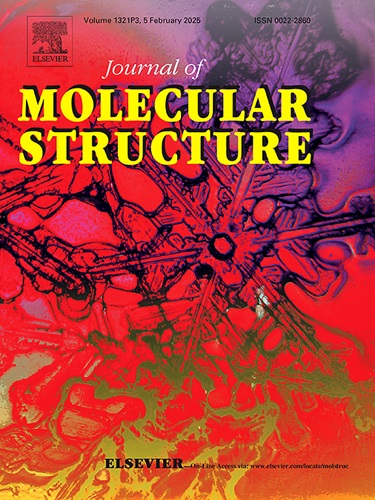Syntheses, crystal structure description, anticancer, antioxidant, enzyme inhibition and DNA interaction potential of neutral hetero- and anionic homoleptic paddle-wheel copper(II) carboxylates
IF 4
2区 化学
Q2 CHEMISTRY, PHYSICAL
引用次数: 0
Abstract
The synthesis of neutral heteroleptic [Cu2{(C6H3F2)CH2COO}4(2-CH3Py)2] (1) and anionic homoleptic (2-NH2PyH)2[Cu2{(C6H3F2)CH2COO}6] (2) complexes is reported. The carboxylate ligand has shown bridging bidentate and bridging plus monodentate coordination in 1 and 2, respectively. Complexes have adopted monomeric (1) and polymeric (2) paddle-wheel structural units. Hirshfeld surface analyses have shown H∙∙∙H interactions and F∙∙∙H and C∙∙∙H/O∙∙∙H H–bonds as the predominant contributions for the intermolecular interactions in 1 and 2. Complexation have increased the biological potential of the ligand acid HL. The test compounds have shown antioxidant (DPPH & •OH), alpha-amylase inhibition and anticancer activity in the order 1> 2 > HL. In the DNA interaction study by UV–vis absorption titration, complexes 1 (Kb = 0.5 × 104 M−1) and 2 (Kb = 8.6 × 104 M−1) have shown Hyperchromism with no red/blue shifts at 245 nm. Complex 1 has also shown Hypochromism with a minor blue shift (6 nm) at 263 nm (Kb = 9 × 104 M−1). Furthermore, the viscosity of SS-DNA has shown no observable change upon the addition of varying amounts of the test compounds. The UV–vis absorption titrations and viscometry have suggested groove binding interactions between complexes and SS-DNA.
中性异离子和阴离子同型桨轮铜羧酸酯的合成、晶体结构描述、抗癌、抗氧化、酶抑制和DNA相互作用电位
报道了中性异电性[Cu2{(C6H3F2)CH2COO}4(2- ch3py)2](1)和阴离子同电性(2- nh2pyh)2[Cu2{(C6H3F2)CH2COO}6](2)配合物的合成。羧酸配体在1和2中分别表现为桥接双齿配位和桥接+单齿配位。配合物采用单体(1)和聚合物(2)桨轮结构单元。Hirshfeld表面分析显示,H∙∙H相互作用以及F∙∙H和C∙∙H/O∙H氢键是1和2中分子间相互作用的主要贡献。络合作用增加了配体酸HL的生物潜能。测试化合物显示抗氧化(DPPH &;•OH), α -淀粉酶抑制和抗癌活性按1>;2比;霍奇金淋巴瘤。在紫外-可见吸收滴定的DNA相互作用研究中,配合物1 (Kb = 0.5 × 104 M−1)和2 (Kb = 8.6 × 104 M−1)在245 nm处表现出高显色性,无红蓝偏移。在263 nm (Kb = 9 × 104 M−1)处,配合物1也表现出低色性和轻微的蓝移(6 nm)。此外,SS-DNA的粘度在添加不同量的测试化合物时没有明显的变化。紫外-可见吸收滴定和粘度测定表明配合物与SS-DNA之间存在凹槽结合相互作用。
本文章由计算机程序翻译,如有差异,请以英文原文为准。
求助全文
约1分钟内获得全文
求助全文
来源期刊

Journal of Molecular Structure
化学-物理化学
CiteScore
7.10
自引率
15.80%
发文量
2384
审稿时长
45 days
期刊介绍:
The Journal of Molecular Structure is dedicated to the publication of full-length articles and review papers, providing important new structural information on all types of chemical species including:
• Stable and unstable molecules in all types of environments (vapour, molecular beam, liquid, solution, liquid crystal, solid state, matrix-isolated, surface-absorbed etc.)
• Chemical intermediates
• Molecules in excited states
• Biological molecules
• Polymers.
The methods used may include any combination of spectroscopic and non-spectroscopic techniques, for example:
• Infrared spectroscopy (mid, far, near)
• Raman spectroscopy and non-linear Raman methods (CARS, etc.)
• Electronic absorption spectroscopy
• Optical rotatory dispersion and circular dichroism
• Fluorescence and phosphorescence techniques
• Electron spectroscopies (PES, XPS), EXAFS, etc.
• Microwave spectroscopy
• Electron diffraction
• NMR and ESR spectroscopies
• Mössbauer spectroscopy
• X-ray crystallography
• Charge Density Analyses
• Computational Studies (supplementing experimental methods)
We encourage publications combining theoretical and experimental approaches. The structural insights gained by the studies should be correlated with the properties, activity and/ or reactivity of the molecule under investigation and the relevance of this molecule and its implications should be discussed.
 求助内容:
求助内容: 应助结果提醒方式:
应助结果提醒方式:


